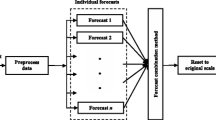Abstract
In the field of forecasting, there are always more than one method to deal with a problem, and more than one institute will supply their own research on the same problem. It’s hard to say which method or information source is better, so the research how to make full use of all the information that we have is valuable. In this paper, we proposed a new fusion method to make full use of all kinds of forecast information to improve the performance of forecasting and made an application to oil price forecast fusion by it. This approach presented a stable and great performance. What’s more, it doesn’t require training data, little limit of the source data, no complex computation, and it also provides a solution to combination puzzle.





Similar content being viewed by others
References
Abramson B, Finizza A (1995) Probabilistic forecasts from probabilisticmodels: a case study in the oil market. Int J Forecast 11(1):63–72
Alvarez-Ramirez J, Soriano A, Cisneros M, Suarez R (2003) Symmetry/anti-symmetry phase transitions in crude oil markets. Phys A 322:583–596
Andrawis RR, Atiya AF, El-Shishiny H (2011) Forecast combinations of computational intelligence and linear models for the NN5 time series forecasting competition. Int J Forecast 27:672–688
Andreas Graefe, Scott Armstrong J, Randall J. Jones Jr., Alfred G. Cuzán (2014) Combining forecasts: an application to elections. Int J Forecast 30:43–54
Assaad M, Bone R, Cardot H (2008) A new boosting algorithm for improved time-series forecasting with recurrent neural networks. Inf Fusion 9(1):41–55
Barrow DK, Crone SF (2016) A comparison of AdaBoost algorithms for time series forecast combination. Int J Forecast 32:1103–1119
Cheng Hsiao, Shui Ki Wan (2014) Is there an optimal forecast combination? J Econ 178:294–309
Claeskens G, Magnus JR, Vasnev AL, Wang W (2016) The forecast combination puzzle: a simple theoretical explanation. Int J Forecast 32:754–762
Conflitt C, De Mol C, Giannone D (2015) Optimal combination of survey forecasts. Int J Forecast 31:1096–1103
Cortes C, Vapnik V (1995) Support-vector networks, maching learning 20:273–297
De Gooijer JG, Hyndman RJ (2006) 25 years of time series forecasting. Int J Forecast 22:443–473
Drucker H (1997) Improving regressors using boosting techniques. In: The fourteenth international conference on machine learning, Morgan Kaufmann Inc, pp 107–115
Duin RPW, Tax DMJ (2000) Experiments with classifier combining rules, multiple classifier systems, Lecture notes in computer science, vol. 1857, pp 16–29
Freund Y, Schapire RE (1997) A decision-theoretic generalization of on-line learning and an application to boosting. J Comput Syst Sci 55:119–139
Hagen R (1994) How is the international price of a particular crude determined? OPEC Review 18(1):145–158
Hastie T, Tibshirani R, Friedman J (2009) The elements of statistical learning. Springer, New York
Lam L, Suen CY (1997) Application of majority voting to pattern recognition: an analysis of its behavior and performance. IEEE Trans Syst Man: Syst Hum 27(5):553–568
Mirmirani S, Li HC (2004) A comparison of VAR and neural networks with genetic algorithm in forecasting price of oil. Adv Econ 19:203–223
Mohammadi H, Su L (2010) International evidence on crude oil pricedynamics: applications of ARIMA-GARCH models. Energy Econ 32:1001–1008
Perols J, Chari K, Agrawal M (2009) Information market-based decision fusion. Manage Sci 55(5):827–842
Samuelsa JD, Rodrigo M. Sekkel (2017) Model confidence sets and forecast combination. Int J Forecast 33:48–60
Suen CY, Lam L (2000) Multiple classifier combination methodologies for different output levels. In: multiple classifier systems, Lultiple Classifier Systems. MCS 2000. Lecture Notes in Computer Science, vol 1857. Springer, Berlin, pp 52–66
Wei YG, Lim CP, Peh KK (2003) Predicting drug dissolution profiles with an ensemble of boosted neural networks. IEEE Trans Neural Networks 14(2):459–463
Xie JR, Hong T (2016) GEFCom2014 probabilistic electric load forecasting: an integrated solution with forecast combination and residual simulation. Int J Forecast 32:1012–1016
Xie W, Yu LA, Xu SY, Wang SY (2006) A new method for crude oilprice forecasting based on support vector machines. Lect Notes Comput Sci 3994:441–451
Yu LA, Wang SY, Lai KK (2008) Forecasting crude oil price with anEMD-based neural network ensemble learning paradigm. Energy Econ 30:2623–2635
Zhang JS, Feng X, Zou SH (2014) On China’s coal demand forecast model based on the trend combination. Commer Res 446:51–56
Author information
Authors and Affiliations
Corresponding author
Rights and permissions
About this article
Cite this article
Ye, Y., Zhang, J., Huang, Z. et al. A new information fusion method of forecasting. J Ambient Intell Human Comput 10, 307–314 (2019). https://doi.org/10.1007/s12652-017-0666-2
Received:
Accepted:
Published:
Issue Date:
DOI: https://doi.org/10.1007/s12652-017-0666-2




